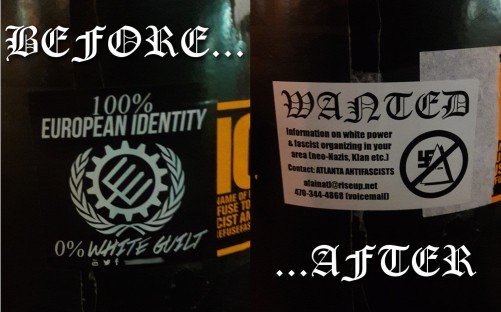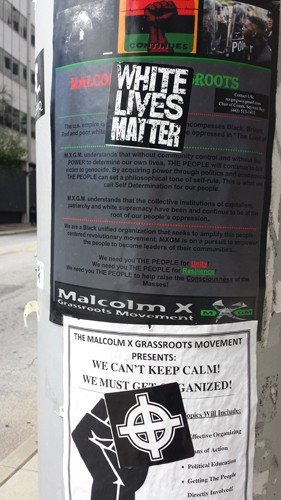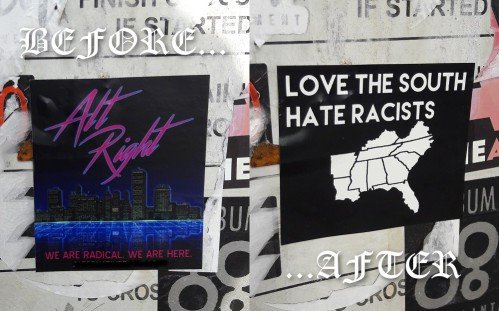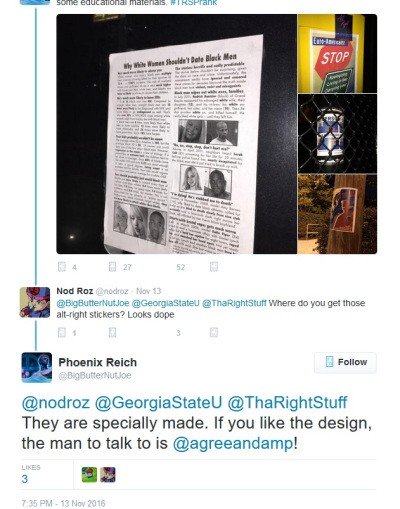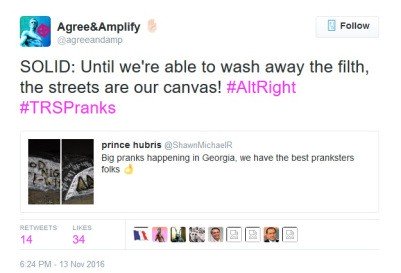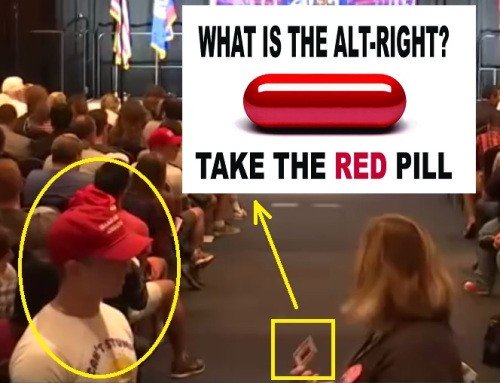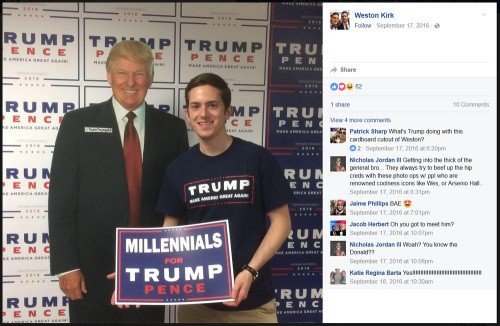Filed under: Analysis, Anti-fascist, Education, Southeast
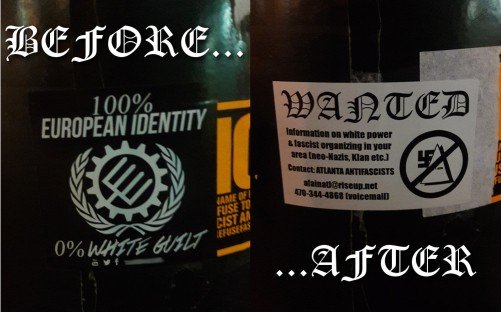
Introduction
On Sunday, February 19th of this year, anti-racists removed nine white power stickers which had recently been placed around Georgia State University (GSU) campus in Atlanta. With one exception — propaganda for the white nationalist Traditionalist Worker Party being spotted for the first time — it was a typical evening, since removing racist propaganda from GSU as well as Georgia Tech and Kennesaw State University campuses had become almost routine by this stage. Indeed, anti-racists had become so efficient at removing white supremacist materials that many GSU students only noticed anti-racist messages around campus, without realizing that some of these had been placed in direct response to far-Right and racist “white pride” materials.
This article provides context about recent organized bigotry on GSU campus, by discussing its precursors: white nationalist efforts at Georgia State University from late 2015 until the end of last year. Our focus is racist agitation by Patrick Nelson Sharp, who made headlines when he tried to form a White Student Union at GSU when he began there in 2013. Sharp graduated GSU with a bachelor’s degree at the end of 2016. White nationalist activism at GSU during this time was not limited to Patrick Sharp’s efforts, but Sharp was at the center of plenty of it, enough that by telling his individual story we can also tell the larger story of racist campus activism.
Patrick Nelson Sharp
We believe it is important to write about Sharp’s activities, even months after Sharp has left Georgia State campus. Although Sharp himself has left, his playbook is in use by racist organizers still a part of the student body. Just as Patrick Sharp’s 2013 White Student Union at GSU (later the “Atlanta Area White Student Union”) first tried to mimic Matthew Heimbach’s White Student Union at Towson University in Maryland, current far-Right racist organizers at Georgia State University may be improvising around themes played earlier by Sharp.
We are skipping Sharp’s 2013 “White Student Union” effort, since this was covered extensively by media outlets and bloggers. We take up the story a couple of years later, when many assumed that Sharp had settled into typical student life, or gone quiet.
Sticker and Poster Campaigns
In our first full article for this site, we discussed the wave of white power and far-Right stickers plastered around Georgia State University campus during September and October 2015. Most of these stickers were purchased from Tightrope, an online distributor of Klan and neo-Nazi materials whose logo is a white fist holding a hangman’s noose. We argued that there was “very strong reason to believe” that Patrick Sharp — frequently seen on campus sporting esoteric fascist symbols — was responsible for placing the stickers around GSU, and we noted that on a couple of occasions Sharp was sighted “in the immediate vicinity of where stickers appeared.”
“White Lives Matter” and celtic cross stickers placed over posters for Black leftist organization, GSU September 2015 (complete photo album of far-Right propaganda at GSU during Fall 2015 is here.)
In November, as students were beginning to speak out about the racist and far-Right materials that had appeared on campus in the months prior, GSU student newspaper The Signal published an article stating that Patrick Sharp had “refuted” claims he was responsible for the stickers, although he believed they should be left alone. The Signal stated that Sharp was an “easy scapegoat” for the stickers and quoted him as saying he was being targeted by “lunatics.” Finally, the article suggested that there was some analogy between “White Lives Matter” — a movement consisting of neo-Nazis and white supremacists — and Black Lives Matter, a movement for social and racial justice. Evidence linking Sharp to the GSU white power campaign, or “White Lives Matter” to the furthest reaches of organized white supremacy, was omitted from the article.
The Signal got it wrong. We have subsequently received a written statement from a then-GSU student, corroborating that someone with insignia on his backpack was viewed placing white nationalist stickers in late 2015 — this person being Patrick Sharp. [1] The written account merely adds to our previous case about who was responsible.
After the controversy of late 2015 about white power stickers on campus, far-Right print propaganda on campus subsided until Fall 2016 (though other white nationalist activity took place, see next section.) When such propaganda returned to campus, it was the “Alt-Right” sector of the white nationalist movement, rather than stickers from a Klan and neo-Nazi distributor, that was mostly represented.
In the Summer of 2016, materials for the white nationalist project Identity Evropa appeared twice in downtown Atlanta. It was not until late September, however, that Identity Evropa posters and stickers appeared on GSU campus itself. While Patrick Sharp cannot be conclusively linked to these Identity Evropa propaganda expeditions, Sharp is certainly on good terms with the Identity Evropa project and its activists. We have written extensively about Patrick Sharp being responsible for the “AgreeAndAmp” and “FashyFit” Twitter accounts – it is notable that FashyFit retweets both Identity Evropa materials as well as Identity Evropa leader Nathan Damigo. As we discuss later, Patrick Sharp was recorded giving out business cards that were created by Nathan Damigo for “Alt-Right” public outreach.
In early November, new stickers appeared on GSU campus – initially in small numbers, though they have popped up persistently since then. These stickers promoted the “Alt-Right” and included a web address for Richard Spencer’s white nationalist Radix Journal (the URL now redirects to the broader “Altright” project, which also involves Spencer in a key role.)
Given our argument that Patrick Sharp used the Twitter profiles AgreeAndAmp/FashyFit, it is clear he’s responsible for these “Alt-Right” stickers materials which appeared around Georgia State University campus (and elsewhere in the city.) While Sharp may not have personally placed every sticker — indeed, it’s doubtful that happened — Sharp was cited (as AgreeAndAmp) as “man to talk to” for anyone who wanted copies of these “specially made” materials.
What those Alt-Right stickers? Talk to AgreeAndAmp (AKA Patrick Sharp)
Patrick Sharp had earlier (as AgreeAndAmp) shared the sticker design on Twitter, which was approvingly retweeted by Richard Spencer of Radix Journal and the National Policy Institute.
When Sharp/FashyFit travelled to Germany after his 2016 graduation, he posted a photo of the same “Alt-Right” sticker placed in Hamburg, describing the sticker as “my mark.”
The most ambitious white power agit-prop mission of 2016 — at least as far as metro Atlanta is concerned – involved the GSU, Georgia Tech and Kennesaw State Universities being plastered with racist posters on a single evening, the weekend after the US presidential election in November. These campuses were hit as part of a coordinated national propaganda effort, promoted on Mike Peinovich’s “The Daily Shoah” podcast and his far-Right/racist TheRightStuff website. (Racist posters also appeared at Augusta University in Georgia at around the same time, although it appears someone else may have placed those posters.)
The posters appearing at Georgia State, Tech, and Kennesaw State were all available for download at either the Alt-Right/neoreactionary “Fanghorn Forest” blog or the racist “Unamusement Park” site. Poster themes included “Why White Women Shouldn’t Date Black Men,” “Are You Sick of Anti-White Propaganda?” and so on. Many posters included the web address for TheRightStuff as part of their message. Each of the three campuses was hit with over a dozen posters, as well as with Patrick Sharp’s “Alt-Right” sticker. A large rock associated with a KSU fraternity was also spray-painted with the slogan “Good Night Anti-Whites” (i.e. supporting violence against “anti-whites”) as well as an Alt-Right logo. Twitter user “Phoenix Reich”/@BigButternutJoe claimed responsibility for the racist postering “prank,” noting that “a couple of goys” were responsible for the trip to Kennesaw.
While there is no definitive proof that Patrick Sharp was one of the “goys” who took part in the single-evening GSU, Tech, and KSU poster mission, Sharp’s “Alt-Right” sticker was placed at all three campuses. Patrick Sharp is also a known supporter of TheRightStuff, which was promoted on many of the posters — Sharp is one of two people pictured wearing a TheRightStuff sleeveless shirt during a September 10, 2016 Alt-Right meet-up at Stone Mountain Park. In addition, Sharp (with his AgreeAndAmp account) endorsed the multi-campus action on Twitter, retweeting an image of the KSU fraternity graffiti and commenting: “SOLID: Until we’re able to wash away the filth, the streets are our canvas!”
Patrick Sharp comments on the November 12, 2016 Alt-Right posters/stickers/graffiti in Georgia
After this mass propaganda action in November, Alt-Right stickers continued to occasionally appear around Georgia State University. Atlanta Antifascists also received a written account from a GSU student, who witnessed Patrick Sharp removing an anti-racist poster on GSU campus that had been placed in response to Fall 2016 racist efforts. [2] White power materials have surfaced in Spring of this year around Georgia State, but by this point Sharp had graduated and presumably others had taken over with placing stickers.
On the FashyFit Twitter account, Patrick Sharp is explicit about his rationale behind “fliering, postering, stickers” and similar street-level propaganda measures. As he wrote on January 15, 2017: “Ironically, the goal isn’t to be seen in streets, rather, it’s to have your activism seen online. Think flash demos: In & out […] You don’t have to sit around & wait to become a target for Antifa or police because the goal isn’t a pedestrian reaction.”
Interventions on Campus
While Patrick Sharp stayed busy on campus, connecting with sympathetic (mostly white) students and networking, there are two events during Sharp’s approximately last year on campus where he was particularly visible. These events were Sharp’s intervention along with other far-Right activists during a November 2015 Black student event on campus, as well as Sharp’s distribution of white nationalist propaganda at “Alt-Lite” personality Milo Yiannopoulos talk at GSU in October 2016. Since these two events were politically revealing, we discuss them here.
- Greatest MINDS Symposium, November 4, 2015
The first incident occurred on November 4, 2015, when Patrick Sharp and three associates showed up to an event hosted by Greatest MINDS Society at Georgia State. Greatest MINDS is an organization that aims to “promote scholarship, excellence, leadership and high achievement among the African American and minority student populations and groups […] on campus.” At the start of November 2015, the organization hosted a three-day “Symposium on Race, Urban Culture and Campus Diversity,” with Sharp and his three associates showing up on the middle day.
The three individuals attending along with Sharp were Nicholas Jaden Dicelli (AKA Nicholas Jordan III), Axelle Chatillon (“Lexie”), and Christian Meehan. Dicelli is not a known GSU student, but he used to operate the Occidental Enclave web forum (Dicelli’s user name on Occidental Enclave and on several other forums was “Savant”). The now-defunct Occidental Enclave site was “A Community for Ethnic Westerners” focusing on “Ethnocultural Identity and Preservation” — in other words, it was a white racist forum in pseudo-intellectual garb. Occidental Enclave covered the Sharp’s early attempt to form a White Student Union at GSU in 2013.
The other two of Sharp’s associates were Axelle “Lexie” Chatillon, better known from the GSU Equestrian Society, and Christian Meehan, who is active in College Republicans at Georgia State University. Meehan’s online presence reveals he is interested in the Italian neo-fascist “CasaPound” movement, as well as “Alt-Right” white nationalism and the “suit-and-tie”-style racists of American Renaissance.



Patrick Sharp, Nicholas Dicelli (Nicholas Jordan III), Axelle Chatillon and Christian Meehan make their presence known at Greatest MINDS event at GSU, November 4, 2015.
At the Greatest MINDS symposium event, Sharp, Dicelli, Chatillon and Meehan operated as a bloc. Meehan played a vocal role, while Sharp and Dicelli — who gave the impression of being the “brains” behind the intervention — spent much of their time “silently observing what unfolded,” per an eyewitness. [3] The small group’s aim seemed to be “primarily to intimidate but also observe and disturb.” It’s important to bear in mind Sharp’s notoriety as a white power leader on campus – Sharp’s appearance at a symposium organized to address issues faced by people of color on campus could itself be taken as sending a message. Further, the Greatest MINDS intervention/disruption occurred soon after the campus had been hit repeatedly with white power and fascist stickers.
Another possible goal for the Patrick Sharp contingent may have simply been to create a stir, and to raise their profile on campus. Christian Meehan interjected in the symposium by saying that (paraphrase from eyewitness) “that the reason Black history is not discussed in history courses, etc. is because [of] the lack of contribution to greater world history made by Africans.” (Meehan is a History student.) The eyewitness recalled that Meehan also “would laugh and smile in a very immature way throughout the intense situation.” After the intervention by Sharp’s group, the “the remainder of the event was wasted due to people feeding in to the things said by the white supremacists, which may have very well been the goal” all along.
- Milo Yiannopoulos at Georgia State, October 16, 2016
Patrick Sharp’s next public intervention on campus was almost a year later, and it was before a much more sympathetic crowd. On October 16, 2016, Georgia Millennials for Trump (led by Republican activist and GSU graduate Weston Kirk) collaborated with College Republicans at Georgia State University to host a speaking event for internet harasser, professional Islamophobic and anti-trans activist Milo Yiannopoulos at Georgia State. (Yiannopoulos gave a speech at Emory University in Atlanta earlier in 2016.) The announcement for the large but high-security rally stated “Protesting will be prohibited inside the event.” The potential for protesters may also have been why the event was not promoted with posters and print materials across campus.
Yiannopoulos is part of the “Alt-Lite” – that is, on the margins of the Alt-Right narrowly construed. As well as being a high-profile bigot, Yiannopoulos is gay and Jewish (by ancestry, not religion) — these two attributes do not necessarily preclude involvement in the Alt-Right, but also may raise suspicion within it. (If you’re interested in those two cans of worms, see articles here and here.) Yiannopoulos is however a popularizer of the Alt-Right, having written “An Establishment Conservative’s Guide to the Alt-Right” for Breitbart (which Yiannopoulos has since left). Yiannopoulos has also received sustained criticism from Alt-Right participants, for portraying the movement as one where seemingly racist claims are usually made just “because it gets a reaction” from moralistic liberals — not out of sincere white supremacist conviction. Ideologically committed white racism is a fringe phenomenon within the Alt-Right, per Yiannopoulos’ faulty characterization. Alt-Right leaders and grassroots participants took offense at Yiannopoulos’ characterization, because they view race and white nationalism as central to their project.
It is for this reason that Nathan Damigo, the California-based leader of white nationalist organization Identity Evropa, issued a Youtube video on “How the Alt-Right Should Address Milo” in September 2016. In the video, Damigo is explicit that “the Alt-Right is centered on identity and race” and argues that Alt-Right militants should engage with the sympathetic crowds at Yiannopoulos’ speaking talks, by giving out materials representing the “core” of the Alt-Right – white nationalist projects such as the National Policy Institute, TheRightStuff, American Renaissance, and Damigo’s own Identity Evropa. Accompanying the video are links to Damigo’s Photobucket account, to print out double-sided promotional cards asking “What is the Alt-Right?” and promoting the aforementioned racist websites as well as others. (Damigo’s video and the links for print-on-demand promotional materials also appear on the “Fanghorn Forest” website, which hosted the racist flyer designs placed across campuses on November 12.)
Patrick Sharp distributes “Alt-Right” promotional cards at Milo Yiannopoulos GSU event
When Yiannopoulos visited Georgia State, Patrick Sharp followed Damigo’s script. Sharp can be seen in video footage of the event, momentarily talking with someone who had just been handed one of the Damigo-designed business cards [4]. When Patrick Sharp leaves the event with another attendee, Sharp can be seen holding a stack of materials [5].
By circulating white nationalist materials at an event organized by the broader Trump/Republican Right, Sharp gives an example of how committed white nationalists benefitted from and attempted to further radicalize the Trump groundswell. (Yiannopoulos was a particularly unpleasant propagandist within that overall groundswell.) While the organizers of the Yiannopoulos event at GSU may claim that they had no inkling the rally would be used to distribute white power propaganda, there are links between the groups who organized the event and Sharp. Sharp’s associate Christian Meehan — who participated in the Greatest MINDS incident — was Director of Communications for GSU College Republicans for the year of 2015-2016 (Meehan has since switched to Debate Chair.) Georgia Millennials for Trump Chairman Weston Kirk is also friends with Patrick Sharp.
From On-campus to Off-campus…
Patrick Sharp has always been active off-campus as well as on-campus, for example travelling to conferences of the white nationalist American Renaissance as well as the National Policy Institute. Since Patrick Sharp’s graduation approached at the same time as a Right-populist groundswell pushed Trump to the White House (and provided a massive boost to Alt-Right racists along the way) it is difficult to tell which changes in Sharp’s activity result from the changing political context, and which are due to upcoming changes in his personal circumstances. During Fall 2016, Sharp seemed to play a leadership role in off-campus regional “Alt-Right” white nationalist gatherings, such as the September excursion to Stone Mountain, as well as the October Atlanta Alt-Right meet-up documented in our article about Sharp’s internet life.
Sharp is a competent organizer, and Sharp doubtless has others in place at Georgia State to continue the white power organizing he initiated. As his graduation approached, Sharp’s own thoughts appear to have shifted to the broader regional Alt-Right movement, where he is now a leader; to multi-campus efforts such as the coordinated propaganda missions; and finally, to projects which may integrate a college aspect but are part of broader white nationalist community/movement-building. An example of the third category is the idea of Alt-Right collective houses, which AgreeAndAmp (i.e. Sharp) pondered in late 2016.
From the above, it is clear that Sharp’s white racist organizing was not just a college-age enthusiasm, which will vanish the moment Sharp encounters life away from campus. Rather, it seems that Sharp conceives of campus white nationalist work as a way of preparing participants for long-term involvement in the white power movement. Unfortunately, we should expect to hear more from him.
Conclusion
We hope this documentation undermines the myth that Patrick Sharp, had the 2013 “White Student Union” as his only trick, and that when the White Student Union failed to locate a faculty advisor, Sharp largely went inactive. Rather, Sharp tried various approaches on campus, from disruptive actions (at the Greatest MINDS event) to attempts to portray white nationalism with a friendlier face (the Yiannopoulos outreach). Stickers on campus were one sign of broader organizing, and indeed the stickers also spanned from intimidating (some of the Tightrope designs) to potentially more enticing. While Patrick Sharp posted extreme racist and fascist content on Twitter, he also associated with Republican activists.
It is important to remember that Georgia State University administration did not do anything about Sharp’s activities on campus, beyond protecting them as simply one opinion among many on campus, even when Sharp attempted to intimidate others. With white power activity continuing at GSU after Sharp’s departure, the lesson is clear: students can only depend on each other, and allies in the community, when standing up to racist organizing.
For anti-racists, an obvious question is why more was not done to oppose Sharp while he was still at GSU. Sharp was strongly resisted when he attempted to launch the White Student Union in 2013, but opposition dropped off as the story faded. One problem in later years was difficulty piecing together information about happenings around campus, and making a clear case about what Sharp was doing. This underscores the importance of ongoing documentation and analysis. The information-release in this article aims to provide context for students dealing with new signs of white nationalism on GSU campus. A second issue is timing — as anti-fascists, we must try to respond to waves of white power organizing when they are cresting, not when they are receding. This means building groups and networks that are up for the task. We hope to be part of multi-faceted and well-informed responses as organized bigots appear in sight again.
NOTES
[1] Written eyewitness account, records of Atlanta Antifascists. This eyewitness account was received January 2017. Like any statement composed from memory after the passage of time, a few details are not remembered precisely – in this case, details of Sharp’s backpack decorations, as well as when the event took place (statement says December, but was likely a couple of months earlier.)
[2] Records of Atlanta Antifascists, name withheld. This is a different source than cited in Note 1.
[3] Notes from eyewitness, records of Atlanta Antifascists. Different source than Notes 1 and 2.
[4] “MILO at the Georgia Millennials for Trump Rally” Youtube footage, 0:01 – 0:13.
[5] Youtube footage, 1:26:49 – 1:26:51.
![]()


